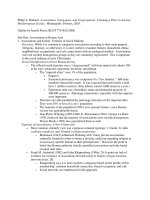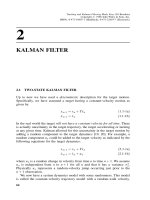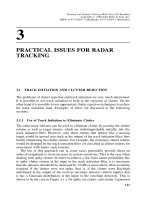Tài liệu Tracking and Kalman filtering made easy P8 ppt
Bạn đang xem bản rút gọn của tài liệu. Xem và tải ngay bản đầy đủ của tài liệu tại đây (55.67 KB, 8 trang )
8
GENERAL FORM FOR LINEAR
TIME-INVARIANT SYSTEM
8.1 TARGET DYNAMICS DESCRIBED BY POLYNOMIAL AS A
FUNCTION OF TIME
8.1.1 Introduction
In Section 1.1 we defined the target dynamics model for target having a
constant velocity; see (1.1-1). A constant-velocity target is one whose trajectory
can be expressed by a polynomial of degree 1 in time, that is, d ¼ 1, in (5.9-1).
(In turn, the tracking filter need only be of degree 1, i.e., m ¼ 1.) Alternately, it
is a target for which the first derivative of its position versus time is a constant.
In Section 2.4 we rewrote the target dynamics model in matrix form using the
transition matrix È; see (2.4-1), (2.4-1a), and (2.4-1b). In Section 1.3 we gave
the target dynamics model for a constant accelerating target, that is, a target
whose trajectory follows a polynomial of degree 2 so that d ¼ 2; see (1.3-1).
We saw that this target also can be alternatively expressed in terms of the
transition equation as given by (2.4-1) with the state vector by (5.4-1) for m ¼ 2
and the transition matrix by (5.4-7); see also (2.9-9). In general, a target whose
dynamics are described exactly by a dth-degree polynomial given by (5.9-1) can
also have its target dynamics expressed by (2.4-1), which we repeat here for
convenience:
X
nþ1
¼ ÈX
n
where the state vector X
n
is now defined by (5.4-1) with m replaced by d and the
transition matrix is a generalized form of (5.4-7). Note that in this text d
represents the true degree of the target dynamics while m is the degree used by
252
Tracking and Kalman Filtering Made Easy. Eli Brookner
Copyright # 1998 John Wiley & Sons, Inc.
ISBNs: 0-471-18407-1 (Hardback); 0-471-22419-7 (Electronic)
the tracking filter to approximate the target dynamics. For the nonlinear
dynamics model case, discussed briefly in Section 5.11 when considering the
tracking of a satellite, d is the degree of the polynomial that approximates the
elliptical motion of the satellite to negligible error.
We shall now give three ways to derive the transition matrix of a target
whose dynamics are described by an arbitrary degree polynomial. In the process
we give three different methods for describing the target dynamics for a target
whose motion is given by a polynomial.
8.1.2 Linear Constant-Coefficient Differential Equation
Assume that the target dynamics is described exactly by the dth-degree
polynomial given by (5.9-1). Then its dth derivative equals a constant, that is,
D
d
xðtÞ¼const ð8:1-1Þ
while its ðd þ 1Þth derivative equals zero, that is,
D
dþ1
xðtÞ¼0 ð8:1-2Þ
As a result the class of all targets described by polynomials of degree d are also
described by the simple linear constant-coefficient differential equation given
by (8.1-2). Given (8.1-1) or (8.1-2) it is a straightforward manner to obtain the
target dynamics model form given by (1.1-1) or (2.4-1) to (2.4-1b) for the case
where d ¼ 1. Specifically, from (8.1-1) it follows that for this d ¼ 1 case
DxðtÞ¼
_
xðtÞ¼const ð8:1-3Þ
Thus
_
x
nþ1
¼
_
x
n
ð8:1-4Þ
Integrating this last equation yields
x
nþ1
¼ x
n
þ T
_
x
n
ð8:1-5Þ
Equations (8.1-4) and (8.1-5) are the target dynamics equations for the
constant-velocity target given by (1.1-1). Putting the above two equations in
matrix form yields (2.4-1) with the transition matrix È given by (2.4-1b), the
desired result. In a similar manner, starting with (8.1-1), one can derive the
form of the target dynamics for d ¼ 2 given by (1.3-1) with, in turn, È given
by (5.4-7). Thus for a target whose dynamics are given by a polynomial of
degree d, it is possible to obtain from the differential equation form for the
target dynamics given by (8.1-1) or (8.1-2), the transition matrix È by
integration.
TARGET DYNAMICS DESCRIBED BY POLYNOMIAL AS A FUNCTION OF TIME
253
8.1.3 Constant-Coefficient Linear Differential Vector Equation for
State Vector X(t)
A second method for obtaining the transition matrix È will now be developed.
As indicated above, in general, a target for which
D
d
xðtÞ¼const ð8:1-6Þ
can be expressed by
X
nþ1
¼ ÈX
n
ð8:1-7Þ
Assume a target described exactly by a polynomial of degree 2, that is, d ¼ 2.
Its continuous state vector can be written as
XðtÞ¼
xðtÞ
_
xðtÞ
xðtÞ
2
4
3
5
¼
xðtÞ
DxðtÞ
D
2
xðtÞ
2
4
3
5
ð8:1-8Þ
It is easily seen that this state vector satisfies the following constant-coefficient
linear differential vector equation:
DxðtÞ
D
2
xðtÞ
D
3
xðtÞ
2
4
3
5
¼
010
001
000
2
4
3
5
xðtÞ
DxðtÞ
D
2
xðtÞ
2
4
3
5
ð8:1-9Þ
or
d
dt
XðtÞ¼AXðtÞð8:1-10Þ
where
A ¼
010
001
000
2
4
3
5
ð8:1-10aÞ
The constant-coefficient linear differential vector equation given by (8.1-9), or
more generally by (8.1-10), is a very useful form that is often used in the
literature to describe the target dynamics of a time-invariant linear system. As
shown in the next section, it applies to a more general class of target dynamics
models than given by the polynomial trajectory. Let us proceed, however, for
the time being assuming that the target trajectory is described exactly by a
polynomial. We shall now show that the transition matrix È can be obtained
from the matrix A of (8.1-10).
254
GENERAL FORM FOR LINEAR TIME-INVARIANT SYSTEM
First express Xðt þ &Þ in a vector Taylor expansion as
Xðt þ &Þ¼XðtÞþ&DXðtÞþ
&
2
2!
D
2
XðtÞÁÁÁ
¼
X
1
¼0
&
!
D
n
XðtÞð8:1-11Þ
From (8.1-10)
D
XðtÞ¼A
XðtÞð8:1-12Þ
Therefore (8.1-11) becomes
Xðt þ &Þ¼
X
1
¼0
ð&AÞ
!
"#
XðtÞð8:1-13Þ
We know from simple algebra that
e
x
¼
X
1
¼0
x
!
ð8:1-14Þ
Comparing (8.1-14) with (8.1-13), one would expect that
X
1
¼0
ð&AÞ
!
¼ expð&AÞ¼Gð&AÞð8:1-15Þ
Although A is now a matrix, (8.1-15) indeed does hold with exp ¼ e being to a
matrix power being defined by (8.1-15). Moreover, the exponent function
GðAÞ has the properties one expects for an exponential. These are [5, p. 95]
Gð&
1
AÞGð&
2
AÞ¼G½ð&
1
þ &
2
ÞAð8:1-16Þ
½Gð&
1
AÞ
k
¼ Gðk&
1
AÞð8:1-17Þ
d
d&
Gð&AÞ¼Gð&AÞA ð8:1-18Þ
We can thus rewrite (8.1-13) as
Xðt þ &Þ¼expð&AÞXðtÞð8:1-19Þ
Comparing (8.1-19) with (8.1-7), we see immediately that the transition matrix
is
Èð&Þ¼ expð&AÞð8:1-20Þ
TARGET DYNAMICS DESCRIBED BY POLYNOMIAL AS A FUNCTION OF TIME
255
for the target whose dynamics are described by the constant-coefficient
linear vector differential equation given by (8.1-10). Substituting (8.1-20) into
(8.1-19) yields
Xðt
n
þ &Þ¼Èð&ÞXðt
n
Þð8:1-21Þ
Also from (8.1-15), and (8.1-20) it follows
Èð&Þ¼I þ &A þ
&
2
2!
A
2
þ
&
3
3!
A
3
þÁÁÁ ð8:1-22Þ
From (8.1-17) it follows that
ðexp &AÞ
k
¼ exp k&A ð8:1-23Þ
Therefore
½Èð&Þ
k
¼ Èðk&Þð8:1-24Þ
By way of example, assume a target having a polynomial trajectory of degree
d ¼ 2. From (8.1-10a) we have A. Substituting this value for A into (8.1-22) and
letting & ¼ T yields (5.4-7), the transition matrix for the constant-accelerating
target as desired.
8.1.4 Constant-Coefficient Linear Differential Vector Equation for
Transition Matrix È
A third useful alternate way for obtaining È is now developed [5. pp. 96–97].
First, from (8.1-21) we have
Xð&Þ¼Èð&ÞXð0Þð8:1-25Þ
Differentiating with respect to & yields
d
d&
Èð&Þ
Xð0Þ¼
d
d&
Xð&Þð8:1-26Þ
The differentiation of a matrix by & consists of differentiating each element
of the matrix with respect to &. Applying (8.1-10) and (8.1-25) to (8.1-26)
yields
d
d&
Èð&Þ
Xð0Þ¼AXð&Þ
¼ AÈð&ÞXð0Þð8:1-27Þ
256
GENERAL FORM FOR LINEAR TIME-INVARIANT SYSTEM









